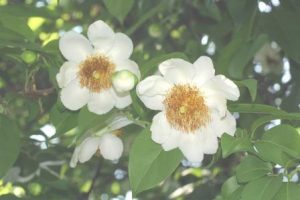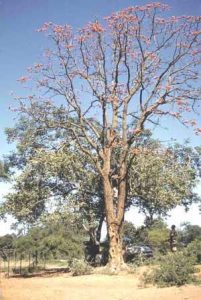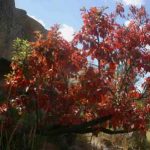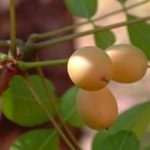TREE LIFE
MAY 1981
MASHONALAND CALENDAR
Tuesday 5th May : Botanic Garden Walk. Met at the car park at 1645 hours.
Sunday 17th : A visit Bythorn, Woodlands and Ceres Farms in the Shamva District.
Woodlands Farm is famous for its Cordias (and they may still be flowering) and Ceres Farm has a fascinating and unique piece of forest.
Bus leaves Monomatapa Car Park at 0830 hours. There will be a Security Guard at the Monomatapa Car Park. The cost of the fare will be $5.00 per person and as Mrs. Lola Irvine has returned from her travels we return to normal and bookings and payments should be made to her at 1 Fairbridge Avenue, Belgravia.
Saturday 6th June 1100 hours : Botanic Garden Walk. As usual during winter, when it gets dark so early, we shall hold our walk on the first Saturday of the month at 1100 hours instead of on the first Tuesday in the evening.
BOTANIC GARDEN WALK – TUESDAY 7 APRIL
Tom Muller took us for a “walk in the low veld” and we were bombarded with all sorts of unfamiliar trees. Many of the trees we examined were small and bushy, but Tom explained that in their preferred habitat they are often very spectacular trees.
Triplochiton zambesiacus with its distinctive lobed leaves being characteristic, is endemic to the Zambezi Valley, but can also be seen on the Karroo Sands between Wankie and Victoria Falls. There it becomes an enormous multi trunked tree.

Oncoba spinosa. Photo: Bart Wursten. Source: Flora of Zimbabwe
Oncoba spinosa was a very attractive tree being in full leaf and fruit and in addition displaying the very beautiful primitive looking white flowers. Tom assured us that the fruit are edible, but they have a rather strange and pungent smell.
Xanthocercis zambesiaca occurs both in our Southern and Northern Lowveld, where it is a spectacular tree. The small black berries are edible and give this species its common name “Nyala berry”.
Albizia zimmermannii is restricted to the Northern Lowveld. It can easily be mistaken for the Mountain Acacia, Brachystegia glaucescens.
Phyllanthus engleri was most interesting. It is a member of the Euphorbiaceae, and restricted to the North East Lowveld. Leaves appear at first to be compound, but are, in fact, simple – the apparent compound leaf being a branch. These leaf bearing branches are deciduous.

Erythrina livingstoniana. Photo: Darryl Plowes. Source: Flora of Zimbabwe
Tom pointed out the rare Erythrina livingstoniana to us. The species occurs at low altitudes on kopjes. The Erythrinas form an interesting group, for they appear to have evolved prior to the split up of Gondwanaland and to have diversified since, on most continents. There are over 100 species worldwide, and all are similar in many aspects to Southern Africa’s seven species.
A specimen of the creeper Adenia karibaensis is growing well in the gardens; its swollen stem similar to that of A. digitata which we often see. A. karibaensis is, like A. digitata, known to be highly toxic, the poison effecting the heart.
VISIT TO DENBY FARM, BEATRICE
Having arrived at Denby Farm, Mr. Walker who had farmed there for over 20 years gave us a few details such as that the altitude was 4 250ft above sea level, the nearby river was the Mtsike which flowed into the Umfuli about 4 miles further down and the fact that we were on granite sandveld. I then added that as we had done a recce, we would not have problems with identifications. I can assure you that is the last time I shall make that sweeping statement. Our problems were more than usual but turned out to be most interesting. Tarchonanthus camphoratus was the first one. This was the tree with the grey and white leaves which I believe few of us have seen in the wild in our area. This is a member of the daisy family which was called Compositae but is now called Asteraceae. It has small thistle like flowers and when in fruit superficially looks as though it is covered in little balls of cotton wool. As the name suggests the leaves have a camphor smell but this was not as strong as it might have been. I think that trees with aromatic leaves are variable as to when they have their strongest “aromaticity”. Out next problem was Ehretia rigida which to quote Mr. Bob Drummond “is usually found around Bulawayo”. There was also E. obtusifolia or as our lists still call it E. amoena. Both are widespread but not common in Mashonaland and tend to grow on anthills, or as the books always call them termite mounds. Having established that one is looking at an Ehretia the differences between the two are that E. rigida has much smaller leaves which are borne on short spikey lateral branchlets as are the flowers and fruits. The common name Puzzle bush was suggested by the tangled twigs, in fact, a better translation of the Afrikaans “Deurmekaarbos” is probably the every which way bush. Stamperwood, the common name for E. obtusifolia comes from the fact that it is used for making pestles for stamping grain. It has rounder, larger, rougher leaves borne on normal branches. However, to confuse the issue further, intermediate between the two species do occur and it is often difficult to distinguish the hybrids from the parents. Of the same family Boraqinaceae, which we later found in the forest with much rougher leaves was Cordia sinensis, the grey leaved Cordia, which we previously saw last June at Upper Hallam Dam. Canthium huillensis was the Rubiaceae sapling in flower and the very thorny member of the same family was Xeromphis obovata and not Canthium frangula as we had thought. When we have the opportunity to compare these two species the points to look for are the texture of the leaves; X. obovata has a thinner texture and while it can have hairs it is not as densely velvety. Petiole tends to be obscured by the decurrent leaf base and it is also usually found at lower altitudes. There were several Vangueria infausta and Vangueriopsis lanciflora but every one refused to argue about which was which – maybe we have learnt to tell them apart at last, when they are characteristic anyway. The Grewia with the square stem was Grewia flavescens after all, even though it had only 2-lobed fruit and much rounder leaves. However, it was the rarer variety var. olukondae which is described as scattered while var. flavescens is described as widespread.
The afternoon walk into the echoing riverine forest and along the river in various directions and for distances and reasons added to the enjoyment of each to do their own thing. We found Combretum erythrophyllum and Rhus quartiniana in full fruit and Croton gratissimus in full lavender scent.
As one of the members said afterwards “when we arrived several of us thought it looked an unpromising place. But we changed our minds in a very short time. There was such a variety of trees right beside the bus and in no time at all I saw several I had never heard of before”. It was indeed an interesting piece of bush – just sandveld bush but what a variety of trees. I think we will always remember this as our Diospyros lycioides day. This we found everywhere in full red fruit, a sight seldom seen as it so delectable that only the early risers beat the birds to it. And talking of birds here is a super P.S. from Cheryl :
THE ‘ORNS’ WERE THERE TOO!
The birdie types found Denby to be a paradise. 53 species of bird were seen. Most interesting was the heronry in some dead trees in the dam (on the Mtsike River). Great white egrets, reed cormorants and white breasted cormorants were nesting; the great whites being involved in feeding their well grown chicks. Grey herons and cattle egrets were also in attendance, but no nests of these species were seen. Five open bill storks sat preening among the branches – more rarely seen species than the others.
It was good to see these birds roosting and raising chicks unmolested, as fishermen were present in good numbers.
As promised we have been monitoring the Zimbabwe Science News and of course no sooner had we stopped our bulk subscription than there was an entire issue that we think would be of interest to all members. Therefore these abstracts are more lengthy than is usually expected and I should like to thank Paul for them.
THE ZIMBABWE SCIENCE NEWS VOL. 15, NO. 3, MARCH, 1981.
Editorial by R.B. Drummond
The flora of Zimbabwe. “A brief account of how our knowledge of the Zimbabwean flora stands at the moment”.
Plant poisoning in Zimbabwe by R.B. Drummond – Keeper of National Herbarium
Subject headings : Plants poisonous to man, to animals and those poisons used to kill fish. Sub-headings : Poisoning resulting from an overdose of medicine, an overdose of a stimulant, accidental poisoning, toxic hairs and sap, a list of some important plants toxic to animals.
Tissue culture by A.J. Robertson, Botany Department – University of Zimbabwe
“….. the combined efforts of cell and tissue technology are beginning to pay big dividends”. “Could a super-plant be one outcome of cloning?” “Can we conserve our environment by freezing it in a poly bag?”. Subject headings : Orchids, Petunias, Forms of cloning, novel combinations of genes, preserving the gene-pool.
Nodules to the rescue by H.D.L.Corby – Department of Botany, University of Zimbabwe
Aspects of symbiotic nitrogen-fixing root-nodulation are proving useful in some of the classificatory riddles of the legumes. Subject headings : Elongate nodules, round nodules, use in taxonomy.
Indigenous plants as sources of medicinally valuable compounds by J. Tannock – Department of Research and Specialist Services
“It has been said that all Western medicines are poisons” with this dramatic statement in mind Rauvolfia, Dioscorea, Solanum, Datura and Gloriosa species are discussed.
Plant diseases by D.L.Cole – Department of Crop Science, University of Zimbabwe
“It is not surprising that considerable human and financial resources are devoted to restricting the spread of disease”. Subject headings – fungi, Viruses, Bacteria
Toxic tolerance in plant species and populations by J.R.C.Hill, Department of Botany, University of Zimbabwe
“If certain elements or groups of elements predominate in the substrate they can affect the ecological balance either directly by their toxic effects, or indirectly by their antagonistic effects on other elements”. Subject headings – The separation of plant population, measurement of toxic tolerance in plants.
The National Botanic Garden of Zimbabwe by T. Muller, National Herbarium and Botanic Garden.
As long ago as 1902 the people of Salisbury set aside some land approximately 4 km north of the city centre as a place for public recreation. The introductory paragraph discusses the topography, altitude, soil types, natural vegetation and climate. Subject headings – Aims of the Garden, achievements, functions. Sub-headings – Evergreen forest, high and medium altitude savannah woodland, low altitude tree savannah, riverine vegetation, forest outliers and high rainfall woodland. Also included is a full colour map.
Plant Names by G.V. Pope, National Herbarium and Botanic Garden
Man’s reliance on plants for food, medicine, clothing and shelter and his need to distinguish between useful and harmful plants has meant that plants had to be given names. The reasons for giving plants names, what rules apply to giving names and why it is necessary to have so many name changes. Subject headings – Names, name changes.
Indigenous trees of Zimbabwe by T. Gordon
Species covered in this issue – Homalium dentatum
This issue was only on sale for a very short time so I have arranged for a supply to be sent to me for anyone who would like a copy at a cost of 70c. I should have them at the Botanic Garden walk and at our next outing. Otherwise you all have my address.
The National Resources Board have invited us to visit their exhibit “You and Your Natural Resources” at their stand on Steenbuck Square at the Zimbabwe International Trade Fair,
Bulawayo, from 24th April to 3rd May, 1981. They are illustrating well conserved resources, soil, water, wildlife, trees and vegetation and demonstrating that they are easily renewable. If anyone is able to accept this invitation Tree Life in general and myself in particular would be most interested to have a report of your impressions.
MATABELELAND NOTES
Sunday May 3rd : To the Helensvale Block near Glenville. Meet at City Hall care park at 0830 hours. Leader Mr. C. Sykes.
June : We are planning to go to Shashi Wilderness Camp to tag the trees in the camp area, spending the nights of Friday 5th June and Saturday 6th June. We would be delighted if members from other areas could join us at that time. There is water, a building to sleep in, toilets and a gas stove, but no beds, pots etc., therefore take everything with you. Even you own gas cylinder
July 5th : To Hillside Dams. Leader Mr. G. Archer.
Continuing her notes on “Summer in the Matopos” Janet Webber now tells us about the trip to the Mopane Woodland area.
This summer has been one of those heavy rainy seasons which we get from time to time, and we took a close look to what difference it had made. Down in the southern part of the Park in a Mopane area the water table was high and we slop-slopped through some very wet grass. It was interesting to see miniature gardens growing in the rough bark of Mopane trees – in knot holes and forks; there were seedling trees such as Ficus, Securinega virosa, Rhus spp; grasses had grown there and Solanum nigrum, Kalanchoe etc. Their life cycle will not be repeated in every case before the hot dry conditions return.
The rock slopes shone in the sun where water flowed over them and of course everywhere there was green Myrothamnus flabellifolia, the resurrection plant. Grasses were head high in many places and I feel there will be a challenge when seeding times comes in full force, so prickly and penetrating they can be. Although there has been abundant growth and good canopies, it seems that some trees have had too much rain; Commiphora seemed dead on the kopjes. We were fascinated to see the small Biophytum petersianum (Oxalidaceae) which has sensitive leaves, reacting immediately to touch.
Something worthy of note was a White Rhino grazing in the Northern Wild Area with three Yellow-billed Oxpeckers on it – a real triumph in translocation for the National Parks staff.
Paul and I spent the Easter weekend in Bulawayo and had the pleasure of meeting members of the Matabeleland Branch. As this Newsletter should already be “in press” we will tell you about it in the next one. However, at this stage we would like to say a very big “thank you” for a super morning we spent with you.
-Meg Coates Palgrave – Chairperson



